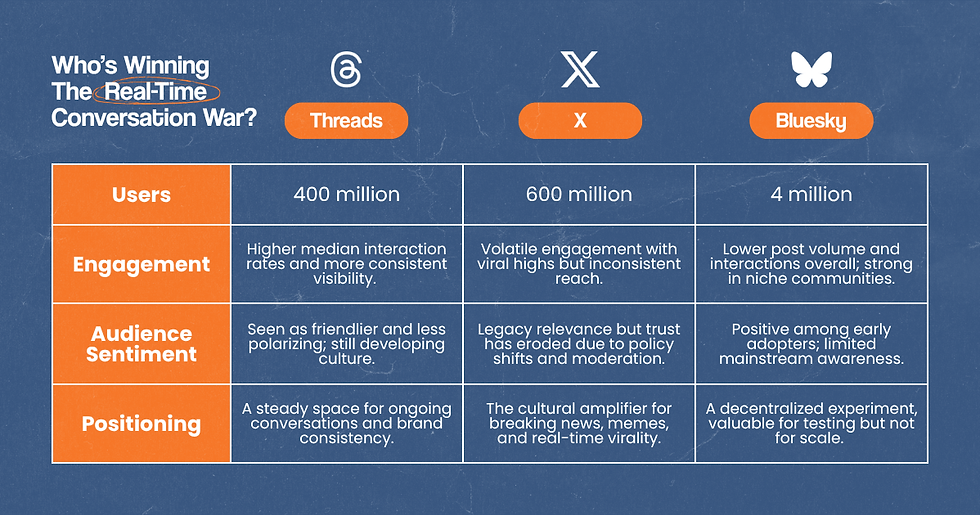What Social Comments Can Tell You, If You’re Paying Attention
- Kelsey Weaver

- Aug 28
- 4 min read
By Kelsey Weaver
If you work in social media, you already know how important it is to listen to your audience. But too often, we treat comments like clutter — something to moderate, delete, or briefly “like” before moving on. The truth is, what your audience says in the comments can be just as valuable as what they engage with on your website or what they click in your emails. When you pay attention, comments can turn into content ideas, campaign strategy, business feedback, and relationship gold.
Let’s break down the signals hiding in plain sight and how to make them work for your brand.

1. Comments as Conversation Starters
Comments aren’t just responses to your content — they’re invitations. When someone replies to your post with a thought, question, or even a quick “this,” they’re opening a window into what’s resonating (or not) and what conversations they’re ready to have. That’s why we watch comments closely when testing new topics, content formats, or tones of voice. A post might get average reach, but if the replies are thoughtful or emotionally charged, that’s a clue you’ve struck a nerve and it might be worth digging deeper.
If a post generates an unusual number of questions or opinions, we take that as a nudge to keep the conversation going. Maybe it’s a behind-the-scenes post that draws curiosity about your process, or a testimonial that opens the floodgates for others to share their stories too. Either way, the replies shape our next move to add value and context. It’s a way to stay in dialogue with the audience instead of just broadcasting to them.

2. Comments as Creative Fuel
Some of the best-performing content we’ve created started in the comments section. When you see the same questions or reactions pop up again and again, that’s not noise — it’s a content roadmap. Your audience is literally telling you what they care about. So, we pay close attention to patterns. Are people confused? Curious? Pushing back? That’s your chance to clarify, educate, or explore from a new angle.
For example, one of our team members noticed that when she posted about community amenities for a homebuilder client, the comments were overwhelmingly positive, often more so than posts about floorplans or available lots. That feedback didn’t just validate the content; it sparked ideas for more posts highlighting lifestyle features and local perks. Those comments became a creative green light to lean further into what their audience actually cares about (which also informs our AIO strategy!).
We’ve used this insight to turn recurring questions into educational carousels, customer praise into testimonials, and even the occasional troll into a clever rebuttal post. It's especially helpful when you’re stuck in a content rut or unsure what direction to take next. When in doubt, go back to the comments — your next big idea might already be sitting there, waiting to be repackaged into something useful and shareable.

3. Comments as Business Intelligence
Think of comments as real-time market research — except it's free and brutally honest. People will tell you what they love, what’s confusing, and what they wish you’d do differently. The feedback might not always be polite or perfectly phrased, but it’s unfiltered insight into how your brand is showing up and being perceived. Whether it’s product questions, complaints, or enthusiastic requests for features, comments reveal gaps in messaging and opportunities to fine-tune your positioning.
One of our team members shared how she turned user comments into business insights. When fans asked for a specific soda flavor to return, she passed that feedback to the product team. When people requested new merch from a popular artist, she sent those ideas to marketing. Comments became actionable data that informed decisions beyond social.
We’ve caught everything from pricing confusion to unclear calls-to-action just by reading replies. Sometimes, a single comment has sparked a full website update or inspired changes to how a client explains their services in email or video. When your audience gives you a peek into their thoughts, don’t waste it. Capture the data, tag the trends, and feed it back into your broader marketing strategy.

4. Comments as Relationship Builders
At the end of the day, social media is meant to be social. When someone leaves a comment — especially one that’s heartfelt, vulnerable, or insightful — that’s a signal they want to connect. Thoughtful replies, follow-ups, and even DMs can go a long way in building trust and loyalty. We treat comments as the beginning of a conversation, not the end of one. That means replying like a real human (not a robot), remembering returning commenters, and sometimes taking the conversation off the feed.
We’ve seen firsthand how this kind of engagement builds community and deepens affinity. One client even grew a newsletter list just by inviting commenters to get more behind-the-scenes tips via email. Another built friendships with repeat commenters who later became brand ambassadors. The point isn’t to reply to every single comment — it’s to recognize the ones that matter and respond in a way that makes people feel seen.
In short: Comments aren’t an afterthought. They’re a living, breathing signal from your audience — one you can use to guide strategy, spark creativity, strengthen relationships, and grow your brand. All you have to do is pay attention.
Kelsey Weaver is a strategic community manager recognized for her creative instincts and thoughtful execution. With over five years of experience managing content for brands across industries, she brings clarity, consistency, and confidence to even the most complex social media landscapes.










